From the day she bought her house in California’s Marin County, Windi Heaton imagined seeing every sunset on her back deck, surrounded by friends, the water and a lush, native landscape. Heaton’s backyard overlooks one of the many lagoons in the small community of Bel Marin Keys; a bird sanctuary and wetland restoration project sit just across the waterway from her home. She already had the view, but her lawn-dominated yard and weathered deck didn’t create the backyard experience she was after. Maintaining the grass also required a lot of resources without enhancing the surrounding ecosystem.
Heaton had remodeled her home herself but knew she needed a designer for this project. “I had no idea how to start,” she says. She wanted a vegetable garden, an organic garden and a place for watching the sunset, among other things, but she didn’t know how to pick out plants or bring all of these ideas together. After discovering local landscape designer Eileen Kelly’s profile on Houzz and seeing that she specialized in sustainable and pesticide-free landscapes, Heaton hired Kelly to transform her outdoor space. “I’d never used a designer before,” says Heaton, but she liked Kelly immediately and felt she would be a great collaborator.
Before Photo
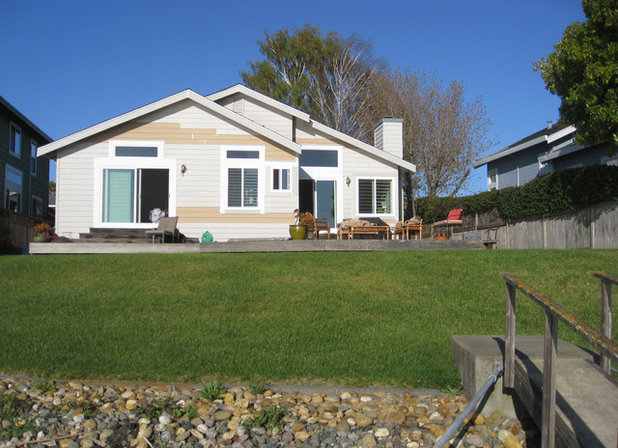
Dig Your Garden Landscape Design
Yard at a GlanceWho lives here: Windi Heaton and her boyfriend, Brian Wilk
Location: Novato, California
Size: 3,000-square-foot backyard and 2,000-square-foot front yard
Completed: Spring 2014
BEFORE: Even before hiring Kelly, Heaton knew she wanted the lawn gone. She wanted to enhance her outdoor living experience but be more respectful of the natural landscape and wildlife. She wanted a chemical-free, low-water and low-maintenance landscape that would also be environmentally beneficial and beautiful. They shut off the lawn’s irrigation for several months before construction and dug out the grass and roots. Through the early stages of the project, Kelly, of Dig Your Garden Landscape Design, sent drought-tolerant plant combinations to Heaton as a way to get a feel for what Heaton liked.
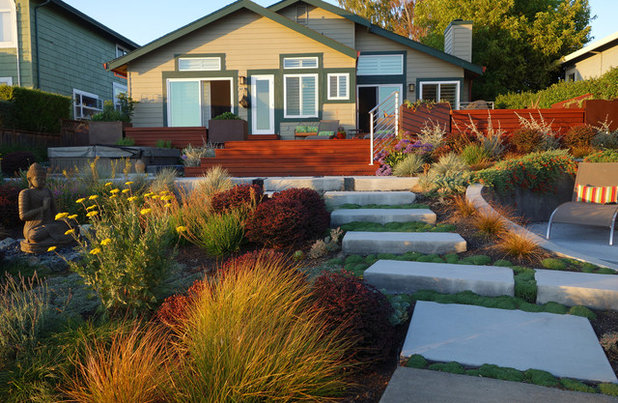
Dig Your Garden Landscape Design
AFTER: Kelly selected a combination of California natives and other low-water Mediterranean plants and succulents in a palette of greens, oranges, yellows, burgundies and purples. “In the Northern California region, I always use plants that are drought tolerant,” she says. “I choose plants that are appropriate for the site conditions — in this case, hot sun, wind and adjacent to the water.” She incorporated a variety of leaf textures, shapes and colors that would offer year-round interest and different flowering times.
The planting offers more than just a new look for the garden. “I use a variety of plant materials that include natives to encourage beneficial insects and birds to help provide a natural balance,” says Kelly. This is something Heaton has experienced firsthand. “It’s amazing how many bees, ladybugs and all kinds of creatures are in my garden now,” she says. “There was nothing before.”
Plants shown (click each photo to see the plants tagged): New Zealand wind grass (
Stipa Arundinacea), Berkeley sedge (
Carex divulsa),
Euphorbia ‘Blackbird’, ‘Hallmark’ bulbine (
Bulbine frutescens ‘Hallmark’), fernleaf yarrow (
Achillea filipendulina ‘Coronation Gold’), orange New Zealand sedge (
Carex testacea), Elfin thyme (
Thymus ‘Elfin’), donkey tail spurge (
Euphorbia myrsinites), blue oat grass (
Helictotrichon sempervirens), parrot’s beak (
Lotus berthelotti), azure bush germander (
Teucrium fruticans ‘Azureum’)
Before Photo
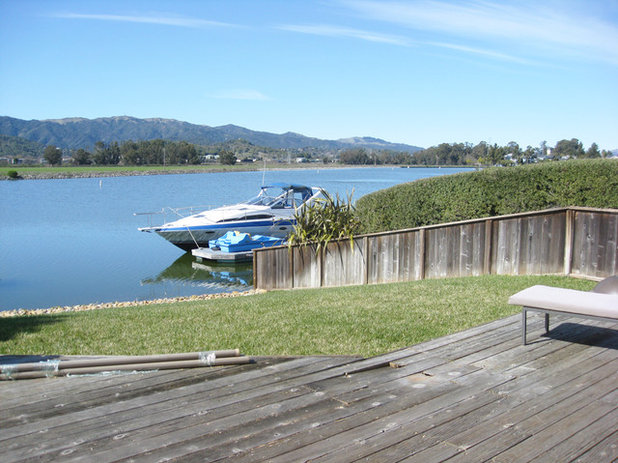
Dig Your Garden Landscape Design
BEFORE: The existing deck overlooked the entire backyard and lagoon but was falling apart.
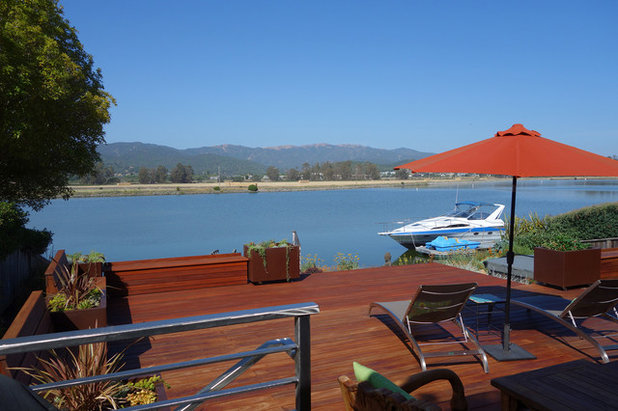
Dig Your Garden Landscape Design
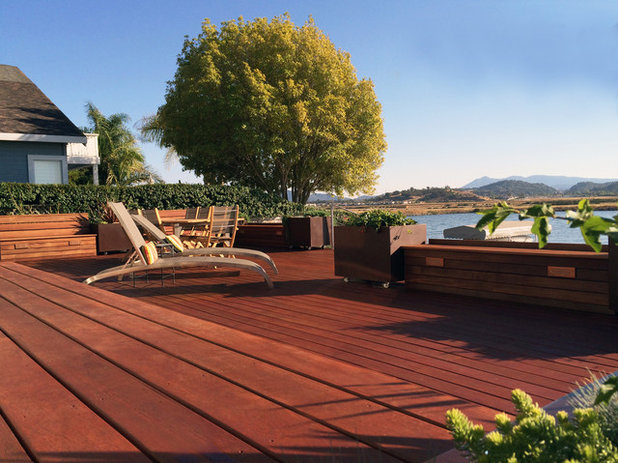
Dig Your Garden Landscape Design
AFTER: Kelly replaced the dilapidated deck with a larger one made from durable and long-lasting cumaru wood, also known as Brazilian teak. Built-in bench seats surround the deck’s perimeter, and contemporary planters overflow with drought-tolerant
Phormium ‘Maori Queen’ and succulents. Kelly put the planters on casters so they can be moved when the deck gets restained. They used the wood from the old deck to build raised beds for Heaton’s edible garden along the side of the yard.
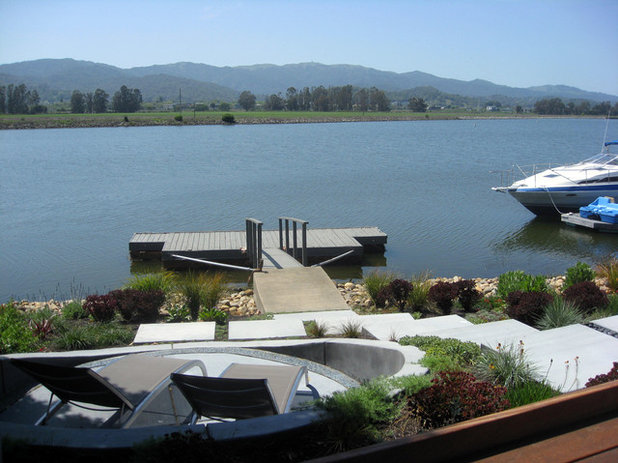
Dig Your Garden Landscape Design
Steps lead off the deck into the lower part of the yard. A path of concrete pavers meanders through the landscape, passing plantings, hidden lookouts and outdoor seating areas on its way down to the lagoon and dock.
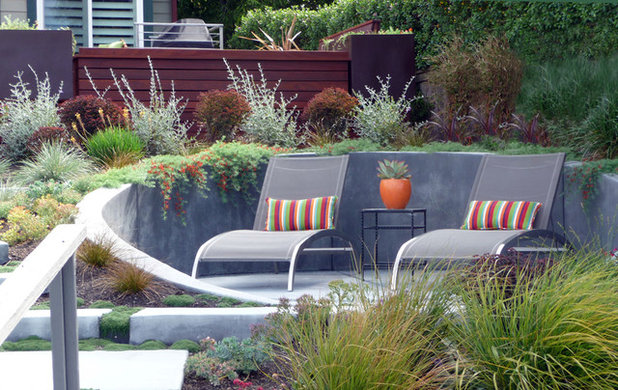
Dig Your Garden Landscape Design
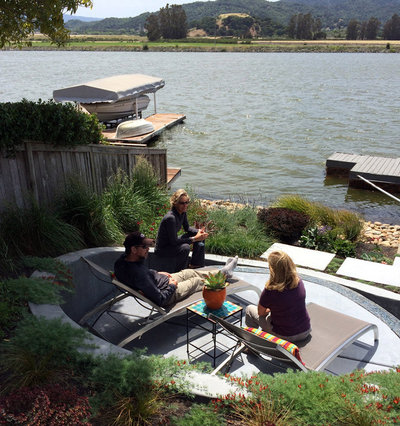
Dig Your Garden Landscape Design
A sunken patio is revealed as you descend into the yard. “I was inspired to create another seating area in the lower, sloped area, closer to the water’s edge, not only as another destination in the landscape, but to also provide a bit more shelter from the wind,” Kelly says. The circular seating area’s concrete wall interrupts the yard’s geometric features and smoothly recedes into the slope as it shelters visitors.
Heaton takes advantage of these seating areas as often as she can. “Basically that’s our main spot,” she says. Before, it was nice to look at the water, but you couldn’t sit and enjoy it. “Now I have friends who are asking to come over,” she says. Her neighbors have taken notice, too. This backyard is very public, since it’s on the waterway, and almost functions like a front yard. “I have people pull up and just stare at it,” says Heaton (shown here). They come up on paddleboard, canoe or kayak. “I’ve met a lot of my neighbors through my backyard,” she says.
Plants shown: Karl Foerster feather reed grass (
Calamagrostis x
acutiflora ‘Karl Foerster’), parrot’s beak (
Lotus berthelotti), orange New Zealand sedge (
Carex testacea),
Euphorbia ‘Blackbird’, Berkeley sedge (
Carex divulsa), New Zealand wind grass (
Stipa Arundinacea)
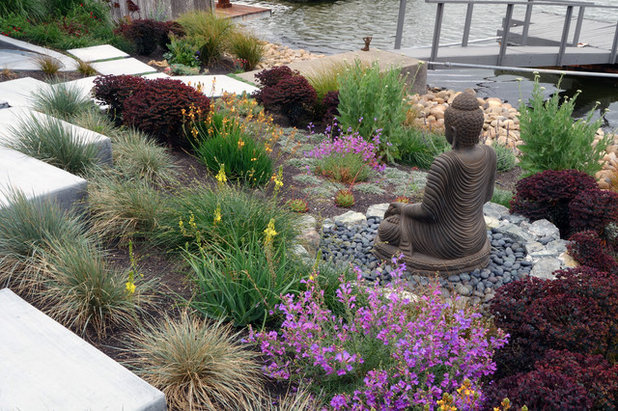
Dig Your Garden Landscape Design
Farther down the path, a Buddha statue watches over the garden, placed by Kelly so that you can admire it from a variety of vantages. Heaton says Kelly was helpful in incorporating things that she wanted in her yard in a way that best complemented the design. “She is able to see those things very clearly,” says Heaton.
Plants shown: Margarita BOP foothill penstemon (
Penstemon heterophyllus ‘Margarita BOP’), blue oat grass (
Helictotrichon sempervirens),
Euphorbia ‘Blackbird’, ‘Hallmark’ bulbine (
Bulbine frutescens ‘Hallmark’),
Echeveria agavoides ‘Lipstick’, silver carpet (
Dymondia margaretae)
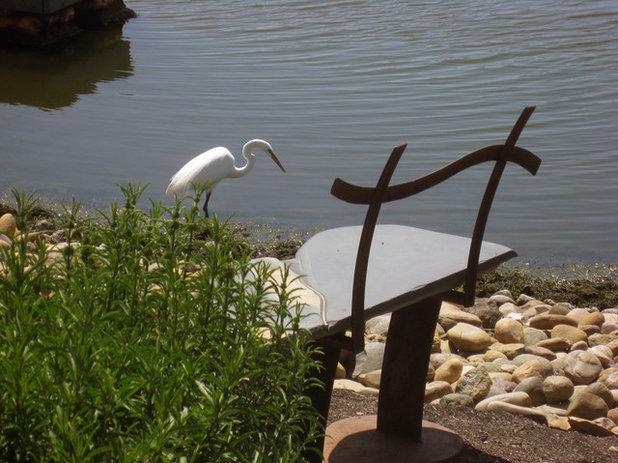
Dig Your Garden Landscape Design
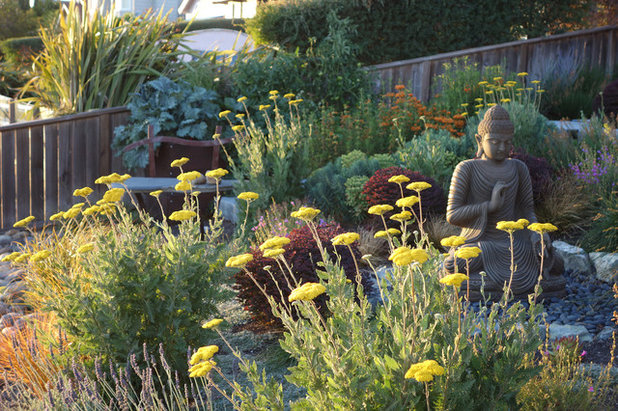
Dig Your Garden Landscape Design
Kelly specified
drip irrigation for smarter and more efficient watering, and used black grape seed compost as a mulch to retain moisture and suppress weeds. “I like to let nature take care of itself as much as possible, without any toxins,” she says.
Heaton says the plants are creating a ground cover as they fill in and are eliminating the need for mulch. “There are hardly any weeds now,” she says. And now that the plants have become established, they can go longer without tending. Sometimes she won’t touch the garden for a week or more, and sometimes she’ll spend a few hours on a weekend cleaning it up. She intends to hire someone once or twice a year to help with big seasonal cleanups.
Plants shown: Achillea ‘Coronation Gold’, Goodwin Creek lavender (
Lavandula ‘Goodwin Creek’), lion’s tail (
Leonotis leonurus),
Euphorbia ‘Blackbird’,
Euphorbia characias wulfenii, Margarita BOP foothill penstemon (
Penstemon heterophyllus ‘Margarita BOP’)
Before Photo
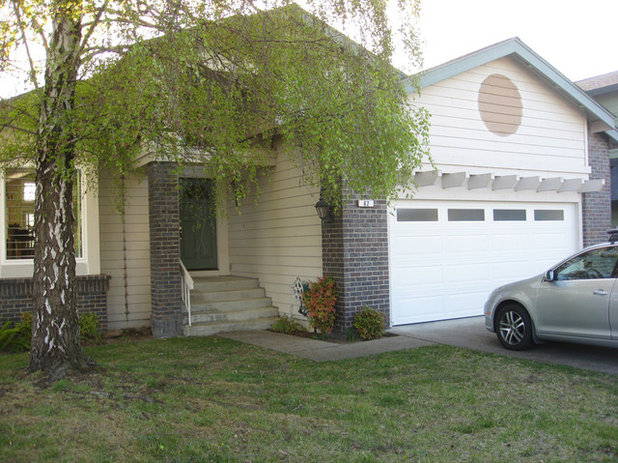
Dig Your Garden Landscape Design
BEFORE: There was more lawn and river rock in the existing front yard. Similar to what she wanted in the backyard, Heaton wanted her entry to be attractive, low maintenance and low water.

Dig Your Garden Landscape Design
AFTER: Kelly blended the entry path and driveway with an irregular, geometric pattern of concrete pavers. Low-growing thyme grows between the pavers to the front door, and inlaid pebbles fit between the driveway pavers. ‘Hallmark’ bulbine (
Bulbine frutescens ‘Hallmark’) and spurge (
Euphorbia sp) enhance the entry’s curb appeal and complement the backyard’s design.
Plants shown: Donkey tail spurge (
Euphorbia myrsinites), ‘Hallmark’ bulbine (
Bulbine Frutescens ‘Hallmark’), orange New Zealand sedge (
Carex testacea), Elfin thyme (
Thymus ‘Elfin’),
Dianella tasmanica ‘Variegata’,
Phormium ‘Black Adder’
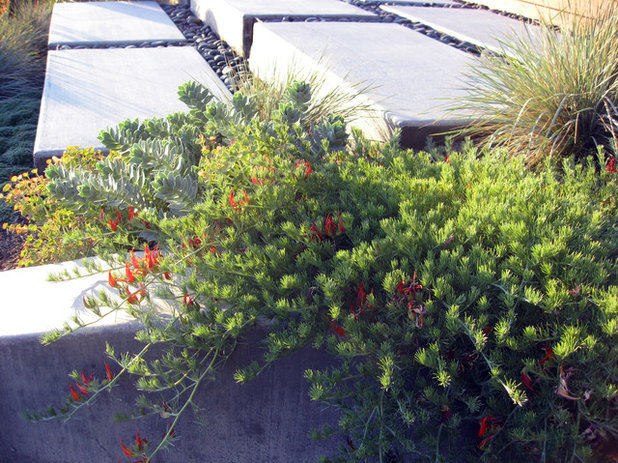
Dig Your Garden Landscape Design
Plants shown: Parrot’s beak (
Lotus berthelotti), blue oat grass (
Helictotrichon sempervirens), donkey tail spurge (
Euphorbia myrsinites)
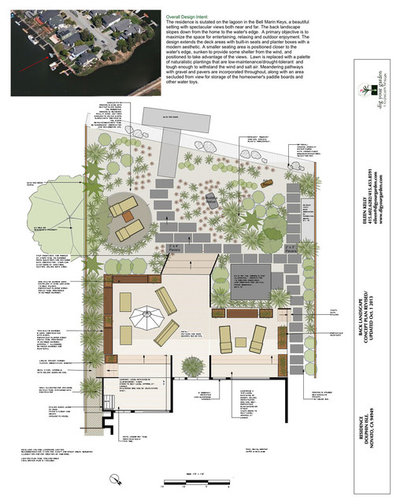
Dig Your Garden Landscape Design
Around the time Heaton hired Kelly, she saw that her local water district was advertising cash reimbursements by the square foot for replacing lawns with low-water plantings. When representatives from the water district came over and examined Heaton’s lawn and Kelly’s proposed design, they liked the solution so much that they invited Heaton’s completed yard to be featured on the North Marin Eco-Friendly Garden Tour. “Most of my neighbors have lawn,” says Heaton, but they are now interested in adopting sustainable plantings.
Eileen Kelly’s tips for an ecofriendlier landscape:- Mulch planting beds to conserve water.
- Use drip irrigation instead of spray (spray promotes weed growth and tends to waste water, since it often sprays areas beyond the plant roots).
- Don’t use pesticides; let the beneficial insects take care of pests, as nature intended.
- Choose plants that have similar watering needs and are appropriate for your site conditions.
- Include a birdbath to encourage birds to visit the garden; they will help to eliminate insect pests.
- Replace water-thirsty and maintenance-heavy lawns to conserve water. There are many alternatives that will also save homeowners money and effort.
- Consult with a knowledgeable maintenance person to check irrigation or breaks and inefficiency at least quarterly.
More Houzz guides:How to contact an architect, a designer or a remodeler and get your project going
How to create and use personal ideabooks on Houzz
Tell us: Has a Houzz pro helped you with a recent project? We’d love to see it!





